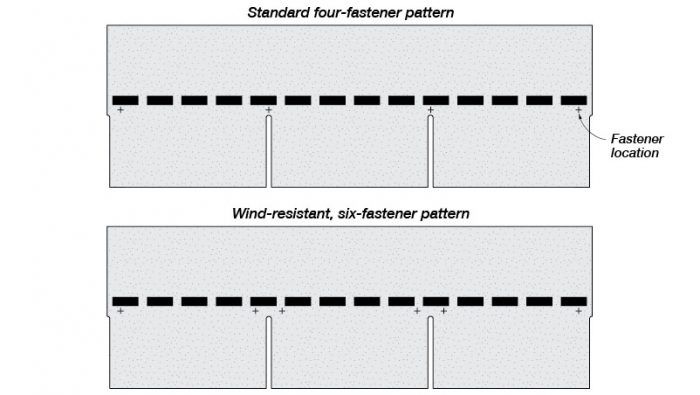Fastener Placement
There's more to nailing an asphalt shingle than just driving in a few fasteners.

It is critical to locate the fasteners at the proper height on the shingle. If you drive them too high, they may blow off. If you drive them too low, the heads will be exposed, making the shingles prone to leaks. Fasteners also have to be located in the correct positions across the shingles. If they are not, the head may be exposed in the cutout slot of the shingle above. Standard shingle installation requires four fasteners per shingle, but in areas prone to high winds, six fasteners may be necessary. Check the manufacturer’s instructions to be sure.
Orient Fasteners Vertically
The target area for fasteners is only ⅜ in. high. On 36-in. x 12-in. shingles, these center points are 5-⅝ in. from the butt edge (see the illustration). On metric shingles, it’s at 6-⅛ in. above the butt. If you are using tabbed shingles, the target points are centered between the cutout and the self-seal strip. Some manufacturers print a target line on their shingles.
Orienting Fasteners
Some roofers incorrectly use the self-seal strip as a target, and sometimes they even nail above the self-seal strip. If the shingles blow off, the manufacturer will check how the shingles were fastened. If they were nailed too high, the warranty will be void and the installer will be held responsible.
Targeting such a narrow line with pneumatic nailers and staplers is difficult, especially when using the bounce-fire method. Hand-nailing is slower but easier to do accurately.
Orient Fasteners Horizontally
There are two nailing patterns for the location of fasteners along the horizontal target line: the standard four-fastener pattern and the six-fastener pattern used for roofs in high-wind areas (see the illustration).
For the four-fastener pattern, place nails at 1 in. and at one-third increments in from each end. On three-tab shingles, the two inner targets are easy to locate because they are directly above the cutouts. For laminated and no-cutout shingles, you’ll have to develop a good sense of where to place nails because measuring isn’t practical. Fasteners driven within ¼ in. left or right of the target are acceptable.
There are two six-fastener wind-resistant patterns. One pattern doubles the fasteners at one-third of the distance in from each end of the shingle; and the other spaces the four fasteners in the field of the shingle evenly apart.
 |
 |
Fine Homebuilding Recommended Products
Fine Homebuilding receives a commission for items purchased through links on this site, including Amazon Associates and other affiliate advertising programs.

Roof Jacks

Flashing Boot Repair

Ladder Stand Off






